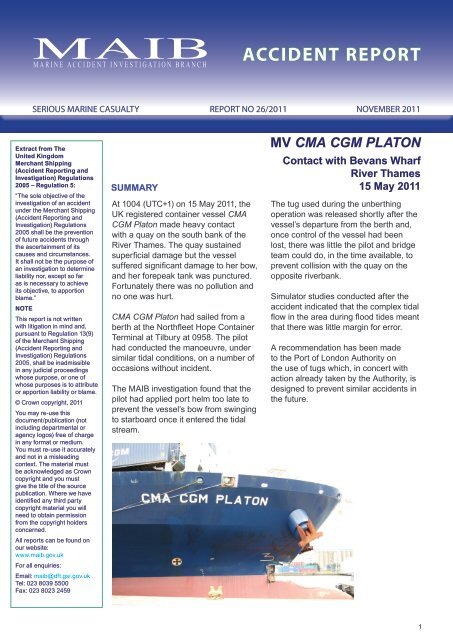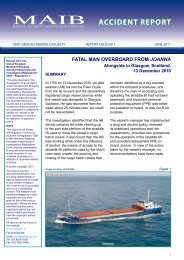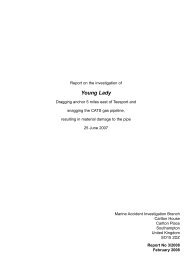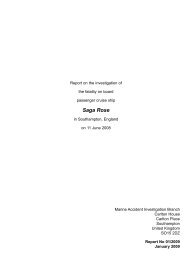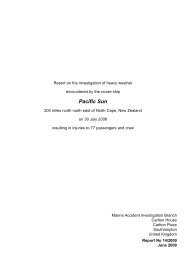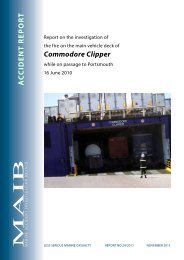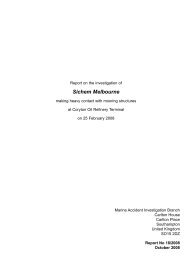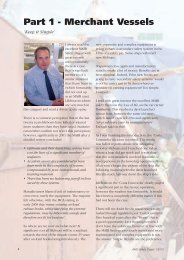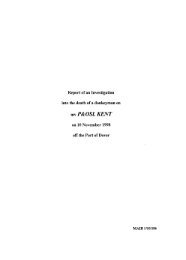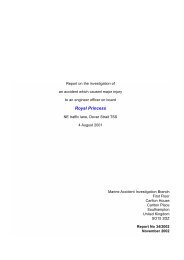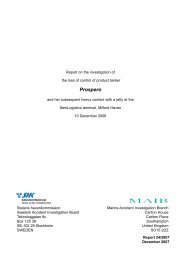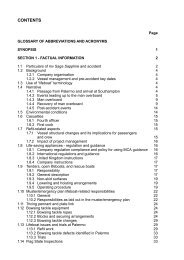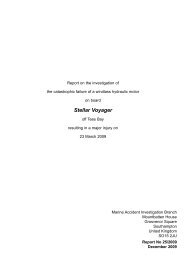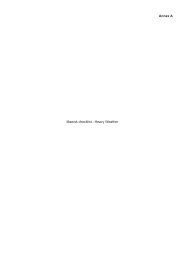ACCIDENT REPORT - Marine Accident Investigation Branch
ACCIDENT REPORT - Marine Accident Investigation Branch
ACCIDENT REPORT - Marine Accident Investigation Branch
You also want an ePaper? Increase the reach of your titles
YUMPU automatically turns print PDFs into web optimized ePapers that Google loves.
M A R I N E A C C I D E N T I N V E S T I G A T I O N B R A N C H<br />
<strong>ACCIDENT</strong> <strong>REPORT</strong><br />
SERIOUS MARINE CASUALTY <strong>REPORT</strong> NO 26/2011 NOVEMBER 2011<br />
Extract from The<br />
United Kingdom<br />
Merchant Shipping<br />
(<strong>Accident</strong> Reporting and<br />
<strong>Investigation</strong>) Regulations<br />
2005 – Regulation 5:<br />
“The sole objective of the<br />
investigation of an accident<br />
under the Merchant Shipping<br />
(<strong>Accident</strong> Reporting and<br />
<strong>Investigation</strong>) Regulations<br />
2005 shall be the prevention<br />
of future accidents through<br />
the ascertainment of its<br />
causes and circumstances.<br />
It shall not be the purpose of<br />
an investigation to determine<br />
liability nor, except so far<br />
as is necessary to achieve<br />
its objective, to apportion<br />
blame.”<br />
NOTE<br />
This report is not written<br />
with litigation in mind and,<br />
pursuant to Regulation 13(9)<br />
of the Merchant Shipping<br />
(<strong>Accident</strong> Reporting and<br />
<strong>Investigation</strong>) Regulations<br />
2005, shall be inadmissible<br />
in any judicial proceedings<br />
whose purpose, or one of<br />
whose purposes is to attribute<br />
or apportion liability or blame.<br />
© Crown copyright, 2011<br />
You may re-use this<br />
document/publication (not<br />
including departmental or<br />
agency logos) free of charge<br />
in any format or medium.<br />
You must re-use it accurately<br />
and not in a misleading<br />
context. The material must<br />
be acknowledged as Crown<br />
copyright and you must<br />
give the title of the source<br />
publication. Where we have<br />
identified any third party<br />
copyright material you will<br />
need to obtain permission<br />
from the copyright holders<br />
concerned.<br />
All reports can be found on<br />
our website:<br />
www.maib.gov.uk<br />
For all enquiries:<br />
Email: maib@dft.gsi.gov.uk<br />
Tel: 023 8039 5500<br />
Fax: 023 8023 2459<br />
SUMMARY<br />
At 1004 (UTC+1) on 15 May 2011, the<br />
UK registered container vessel CMA<br />
CGM Platon made heavy contact<br />
with a quay on the south bank of the<br />
River Thames. The quay sustained<br />
superficial damage but the vessel<br />
suffered significant damage to her bow,<br />
and her forepeak tank was punctured.<br />
Fortunately there was no pollution and<br />
no one was hurt.<br />
CMA CGM Platon had sailed from a<br />
berth at the Northfleet Hope Container<br />
Terminal at Tilbury at 0958. The pilot<br />
had conducted the manoeuvre, under<br />
similar tidal conditions, on a number of<br />
occasions without incident.<br />
The MAIB investigation found that the<br />
pilot had applied port helm too late to<br />
prevent the vessel’s bow from swinging<br />
to starboard once it entered the tidal<br />
stream.<br />
MV CMA CGM PLATON<br />
Contact with Bevans Wharf<br />
River Thames<br />
15 May 2011<br />
The tug used during the unberthing<br />
operation was released shortly after the<br />
vessel’s departure from the berth and,<br />
once control of the vessel had been<br />
lost, there was little the pilot and bridge<br />
team could do, in the time available, to<br />
prevent collision with the quay on the<br />
opposite riverbank.<br />
Simulator studies conducted after the<br />
accident indicated that the complex tidal<br />
flow in the area during flood tides meant<br />
that there was little margin for error.<br />
A recommendation has been made<br />
to the Port of London Authority on<br />
the use of tugs which, in concert with<br />
action already taken by the Authority, is<br />
designed to prevent similar accidents in<br />
the future.<br />
1
FACTUAL INFORMATION<br />
Narrative<br />
CMA CGM Platon was berthed portside to,<br />
facing downstream alongside the Northfleet<br />
Hope Container Terminal. Loading of cargo was<br />
completed at 0250 on 15 May 2011. CMA CGM<br />
Platon was scheduled to leave her berth at 1000<br />
to proceed to Rouen, where the balance of her<br />
cargo was to be loaded, for discharge ports in the<br />
Caribbean Sea and South America.<br />
At 0900, the bridge equipment and steering gear<br />
were tested and, at 0930, the main engine was<br />
tested. All were found to operate satisfactorily. At<br />
0936, the pilot boarded and the engine was set<br />
to ‘standby’. At about 0940, the master and pilot<br />
exchanged information on the vessel’s status<br />
and briefly discussed the planned departure<br />
manoeuvre. The bridge was manned by the pilot,<br />
master, chief officer and a helmsman.<br />
At 0945, control of the main engine was<br />
transferred to the port bridge wing. At 0947, Svitzer<br />
Josephine, a 51-tonne bollard pull tug was made<br />
fast on the starboard quarter. At 0952, the pilot<br />
notified London Vessel Traffic Services (VTS) of<br />
the vessel’s readiness to depart and requested<br />
a traffic update. London VTS advised him of one<br />
outbound and two inbound vessels, which the pilot<br />
considered would not affect his intended departure<br />
manoeuvre.<br />
At 0956, the mooring lines were singled up and<br />
London VTS gave the pilot permission to leave the<br />
berth. The master and pilot then moved to the port<br />
bridge wing manoeuvring console and the master<br />
ordered all lines to be cast off. At 0958, all lines<br />
were reported clear. The pilot then ordered the tug<br />
to pull the vessel’s stern off the berth and operated<br />
the bow thruster to move the bow to starboard.<br />
At 0959, when the vessel was clear and parallel to<br />
the berth, the engine was set to ‘dead slow ahead’<br />
and, at 1000, to ‘slow ahead’. At 1001, the pilot<br />
ordered the helm to ‘port 20º’ and, a few seconds<br />
later, gave instructions for the tug to be cast off. He<br />
then ordered the helm to ‘midships’.<br />
At 1002, the engine was set to ‘half ahead’.<br />
Soon afterwards, the pilot told London VTS that<br />
the vessel was clear of the berth, passing the<br />
bellmouth (Figure 1) and heading towards the<br />
south side of the river.<br />
2<br />
Reproduced from Admiralty Chart BA 2151 by permission<br />
of the Controller of HMSO and the UK Hydrographic Office<br />
Northfleet Hope<br />
Container berth<br />
Bellmouth<br />
AIS track of vessel<br />
Figure 1<br />
At 1003, the engine control was transferred to the<br />
central manoeuvring console, and the master and<br />
pilot returned to the bridge conning position. The<br />
pilot then ordered the helm to ‘port 20º’ and, 12<br />
seconds later, with the bow unexpectedly paying<br />
off to starboard, ordered it to ‘hard-a-port’. He<br />
asked the helmsman if he had moved the helm to<br />
starboard and was informed by the chief officer<br />
and helmsman that the helm was ‘hard-to-port’.<br />
Eleven seconds later, as the bow continued to<br />
pay off to starboard, the master intervened and<br />
suggested to the pilot a need to set the engine full<br />
astern. The pilot immediately agreed.<br />
At 1004, the engine was set to ‘full astern’.<br />
The pilot ordered Svitzer Josephine to return<br />
immediately to assist the vessel. Although CMA<br />
CGM Platon’s engine developed full astern power,<br />
this was insufficient to arrest her headway in the<br />
space available. The vessel narrowly avoided<br />
Cristina Masaveu, a cement carrier moored<br />
alongside Bevans Wharf and, at 1006, at a speed<br />
of 3.7 knots her bow made contact with the quay<br />
(Figure 2). Shortly before the contact, the third<br />
officer, who was at the forward mooring station,<br />
dropped the port anchor in an attempt to slow the<br />
vessel.
Courtesy of Port of London Authority<br />
CCTV image showing contact with quay<br />
Figure 2<br />
An extract of CMA CGM Platon’s voyage data recorder (VDR), covering the relevant period up to the<br />
contact, is provided in Table 1:<br />
Time Heading COG SOG Event<br />
0959:19 169 Dead slow ahead<br />
1000:27 170 180 1.3 Slow ahead<br />
1001:07 Port 20º<br />
1001:18 Let go the aft tug<br />
1001:28 Midships<br />
1002:30 164 171 5.0 Half ahead<br />
1002:53 161 166 5.4<br />
1003:36 162 164 6.3 Port 20º<br />
1003:48 165 166 6.5 Hard-a-port<br />
Pilot reports to London VTS that vessel is clear of the berth and<br />
heading to the south. VTS acknowledged.<br />
1003:59 166 173 7.0 Master advises pilot to apply full astern power<br />
1004:02 167 175 Pilot acknowledges<br />
1004:24 168 181 7.0 Full astern – 61 RPM<br />
1005:50 177 202 3.7 Contact with Bevans Wharf<br />
3
Following the contact, the master and pilot held<br />
the vessel off the berth by using the engine<br />
and bow thruster. At 1012, Svitzer Mercia and<br />
Svitzer Josephine were made fast forward and<br />
aft respectively and full control of the vessel was<br />
restored. The port anchor was recovered and,<br />
at 1104, the vessel docked at the upper berth of<br />
Northfleet Hope Container Terminal.<br />
Environmental conditions<br />
At the time of the accident, visibility was good and<br />
the wind was west-north-west at about 16 knots.<br />
High water at Tilbury was predicted for 1156 with<br />
a predicted height of 6.2m. The actual height of<br />
tide at high water was recorded as 6.1m. The tidal<br />
stream 2 hours before high water was estimated to<br />
be 1.9-2.0 knots.<br />
The tidal stream around<br />
Tilburyness is complex due to the<br />
fluvial flow of the river. During a<br />
flood tide, an outward flow of water<br />
known as the ‘downdrain’ near the<br />
face of Northfleet Hope Container<br />
Terminal interacts with the inward<br />
tidal stream to create a counter-flow<br />
off the berth, as depicted in Figure<br />
3.<br />
Previous accidents<br />
In 2007, a tanker was outbound<br />
from Grays Terminal on an ebb tide.<br />
As the pilot manoeuvred the vessel<br />
around Tilburyness, he lost control<br />
of the vessel and she contacted the<br />
quay at Northfleet Terminal. This<br />
resulted in damage to the vessel’s<br />
shell plating. A contributing factor<br />
was the vessel’s bow entering an<br />
area of counter-flow while her stern<br />
remained in the main ebb flow,<br />
causing her bow to unintentionally<br />
pay off to starboard.<br />
In 2009, an outbound container<br />
vessel left Northfleet Hope<br />
Container Terminal on a flood<br />
tide. Shortly afterwards, the pilot<br />
lost control as he manoeuvred the<br />
vessel around Tilburyness and<br />
she contacted the quay at Bevans<br />
Wharf. The vessel sustained<br />
superficial damage but the quay<br />
and its supporting structures were<br />
4<br />
Courtesy of Port of London Authority<br />
severely damaged. The visibility was poor and<br />
caused the pilot to lose situational awareness. The<br />
vessel’s bow had entered the strong flood tidal<br />
stream while her stern remained in the downdrain,<br />
which caused the vessel’s bow to unintentionally<br />
pay off to starboard.<br />
The PLA investigations revealed that, in both<br />
accidents, tugs had been used for unberthing the<br />
vessels and had then been released and were<br />
unavailable to provide assistance in time to prevent<br />
the vessels from contacting the quay.<br />
The PLA previously operated a paper-based<br />
system for circulating information to its pilots.<br />
This was made available to them in the pilots’<br />
ready room and was also sent to their homes on a<br />
weekly basis.<br />
Tidal flow 2 hours before high water<br />
Downdrain<br />
Counterflow<br />
area<br />
Figure 3
‘Lessons Learnt’ letters, promulgated by the PLA<br />
following the above investigations, highlighted the<br />
following:<br />
• The potential of disturbed tidal flows to cause<br />
loss of control of a vessel. (2007) [sic]<br />
• Where the use of tugs is critical to the<br />
manoeuvre and reduced visibility may have<br />
an adverse effect on the safety of a towage<br />
operation, early consideration should be given<br />
to aborting the manoeuvre. (2009)<br />
Due to an administrative error, the ‘Lessons Learnt’<br />
letter resulting from the accident in 2009 was not<br />
circulated to all pilots.<br />
Since January 2010, the PLA has moved to an<br />
electronic-based system. Information is now<br />
posted on the Pilot Information Register and can<br />
be found on the organisation’s intranet that can<br />
be accessed via the internet. In addition, routine<br />
information is transmitted to the pilots via e-mail.<br />
Risk assessment<br />
The PLA has a formal hazard identification and<br />
risk assessment database. The hazard of vessels<br />
strongly setting and contacting berths or vessels<br />
alongside the southside of Tilburyness was ranked<br />
22 nd out of a possible 116 recorded risks. This<br />
risk assessment, which includes reference to the<br />
possibility of a vessel being caught in local tidal<br />
eddies off Tilburyness, was reviewed in February<br />
2010 following the accident in 2009.<br />
ANALYSIS<br />
The accident<br />
Although CMA CGM Platon’s speed through the<br />
water was about 8.5 knots, the flood tide acting<br />
on her port bow, coupled with the downdrain and<br />
wind acting on her starboard quarter, was sufficient<br />
to overcome the turning effect of the applied port<br />
helm. This resulted in the vessel unexpectedly<br />
turning to starboard.<br />
Although the engine was then set to ‘full astern’,<br />
the vessel’s stopping distance of 4 cables<br />
exceeded the available space ahead and she<br />
consequently made contact with the quay.<br />
The pilotage<br />
The pilot was employed by the PLA and had<br />
served 21 years as a river pilot. In the month prior<br />
to the accident, he had conducted four pilotage<br />
acts from the same terminal on vessels of similar<br />
size.<br />
It was the pilot’s usual practice to release the<br />
assisting tug as soon as he had established that<br />
the vessel had sufficient steerage. Clearing the<br />
bellmouth was his cue for initiating the turn to port.<br />
He had conducted the same manoeuvre many<br />
times in the past and was surprised that after<br />
applying port helm, CMA CGM Platon turned to<br />
starboard. He had never experienced this before<br />
and his initial conclusion was that the helmsman<br />
had incorrectly applied starboard helm. Having<br />
then ordered the helm to ‘hard-a-port’ and received<br />
confirmation that it had been applied correctly,<br />
the pilot surmised that the vessel had suffered a<br />
steering failure.<br />
The near-reciprocal nature of CMA CGM Platon’s<br />
heading and the direction of the flood tidal stream<br />
meant that a small change in the lateral position<br />
of the vessel and/or the edge of the tidal stream<br />
could make a significant difference to the point at<br />
which the vessel’s bow entered the tidal stream.<br />
The fact that, in the pilot’s experience, 20º port<br />
helm applied on clearing the bellmouth caused the<br />
vessel to turn to port indicates that, in each of his<br />
previous manoeuvres, the vessel’s bow had not<br />
yet entered the tidal stream. On this occasion, the<br />
VDR recording shows that the vessel was already<br />
turning to starboard before the ‘port 20º’ order was<br />
given.<br />
5
Exercises conducted on the PLA’s simulator for a<br />
similar type of vessel confirmed that the margin<br />
for error in achieving the intended manoeuvre was<br />
small and, in the prevailing circumstances, the<br />
pilot had unintentionally not applied port helm until<br />
after the vessel’s bow had entered the flood tidal<br />
stream.<br />
Decision to abort<br />
With the helm ‘hard-a-port’ and the vessel’s bow<br />
continuing to pay off to starboard, and the pilot<br />
concluding that the vessel had suffered a steering<br />
failure, the master and pilot agreed to abort the<br />
manoeuvre and set the engine to ‘full astern’.<br />
They both recognised that this action would be<br />
insufficient to prevent the vessel contacting the<br />
quay ahead. However, their immediate aims were<br />
to prevent CMA CGM Platon from hitting the vessel<br />
moored alongside Bevans Wharf and to limit<br />
damage to their own vessel.<br />
Exercises conducted on the PLA’s simulator for<br />
a similar type of vessel indicated that a decision<br />
to continue with the intended manoeuvre to port<br />
or, alternatively, to alter course to starboard<br />
would have resulted in the vessel approaching<br />
dangerously close to the opposite bank of the river,<br />
at speed, with a high risk of incurring significant<br />
additional damage.<br />
Operational towage<br />
CMA CGM Platon’s departure from Northfleet<br />
Hope Container Terminal was conducted in<br />
accordance with PLA’s Code of Practice for Ship<br />
Towage Operations on the Thames (Towage<br />
Code), which required utilising one tug for the<br />
operation. The guidelines contained in the Code<br />
are based on the assumptions that: the weather<br />
conditions are favourable; tidal conditions are<br />
advantageous; and the vessel’s equipment,<br />
including the engines, bow and stern thrusters is<br />
operational and in good working order. All of these<br />
conditions were met.<br />
Currently, there is no requirement in the Code for a<br />
tug to be retained during a vessel’s transit around<br />
Tilburyness. The PLA relies on the judgment of the<br />
pilot to determine to what extent tug assistance is<br />
required. In this case, the pilot had released the<br />
tug soon after clearing the berth and establishing<br />
steerage, as was his custom. He was not required<br />
to retain the tug while rounding Tilburyness and, in<br />
6<br />
his experience, did not feel the need to do so for a<br />
vessel of CMA CGM Platon’s size. However, this<br />
accident might have been prevented had the pilot<br />
retained the tug and used it to assist the vessel<br />
to turn into the flood tidal stream. Alternatively, he<br />
could have used the tug to pull the vessel off the<br />
berth while applying starboard bow thrust until<br />
the vessel had completely entered the flood tidal<br />
stream and was in a safe position to start making<br />
way ahead.<br />
Master/pilot exchange<br />
Soon after boarding, the master and pilot<br />
exchanged information, but this was limited to the<br />
condition and readiness of the vessel. Both the<br />
master, who had previously visited the terminal,<br />
and the pilot considered the departure to be a<br />
routine operation which did not require any further<br />
discussion or elaboration.<br />
However, as advocated in the Towage Code, they<br />
should have discussed the areas of transit that<br />
may have posed a risk and/or required the possible<br />
use of a tug. This might have prompted them to<br />
keep the tug connected until after the vessel had<br />
fully entered the flood tidal stream.<br />
Dissemination of lessons learnt<br />
There was no system to check that the information<br />
circulated to pilots by the PLA had been received<br />
and read. The PLA therefore had no means for<br />
ensuring that the lessons identified in its accident<br />
investigations had been effectively promulgated to<br />
its pilots.
CONCLUSIONS<br />
1. As CMA CGM Platon’s bow entered the main<br />
flood tidal stream, her stern remained in<br />
the downdrain. This, together with the wind<br />
acting on her starboard quarter, caused a<br />
coupling effect, which resulted in the vessel<br />
unexpectedly turning to starboard.<br />
2. The near-reciprocal nature of CMA CGM<br />
Platon’s heading and the direction of the flood<br />
tidal stream meant that a small change in the<br />
lateral position of the vessel and/or the edge<br />
of the tidal stream could make a significant<br />
difference to the point at which the vessel’s<br />
bow entered the tidal stream. The margin for<br />
error in achieving the intended manoeuvre<br />
was small and the pilot had unintentionally not<br />
applied port helm until after the vessel’s bow<br />
had entered the flood tidal stream.<br />
3. This accident might have been prevented had<br />
the pilot retained the option of using the tug<br />
for longer, as he could have used it to assist<br />
the vessel to turn into the flood tidal stream.<br />
Alternatively, he could have used the tug to<br />
pull the vessel off the berth while applying<br />
starboard bow thrust until the vessel had<br />
laterally entered the flood tidal stream.<br />
4. Although the master and pilot’s aborting<br />
manoeuvre was insufficient to prevent the<br />
accident, their primary aims were to avoid<br />
contacting the vessel moored ahead and limit<br />
damage to their own vessel.<br />
5. The master and pilot did not conduct a detailed<br />
exchange of information. Had they discussed<br />
areas of the river transit that may have posed<br />
a risk, they might have decided to retain the<br />
use of the tug until CMA CGM Platon was clear<br />
of the complex tidal flows that exist around<br />
Tilburyness.<br />
6. The PLA had no means for ensuring that the<br />
lessons identified in its accident investigations<br />
had been effectively promulgated to its pilots.<br />
ACTIONS TAKEN<br />
The Port of London Authority has:<br />
1. Included the scenario of a container vessel<br />
leaving the lower berth at Northfleet Hope<br />
Container Terminal on the flood tide when<br />
berthed heading downstream, as part of<br />
the pilots’ training, refresher training and<br />
revalidation.<br />
2. Included tug skippers from both towage<br />
companies operating on the river in simulator<br />
training exercises.<br />
3. Undertaken further work to identify the most<br />
effective utilisation of the various types of tugs<br />
in use on the river.<br />
4. Reviewed the risk assessment relating to this<br />
incident. Subject to the findings of the review<br />
panel, an addition to the Towage Code will be<br />
made to cover the berth-specific element.<br />
5. Created a ‘Lessons Learnt’ link on the<br />
port’s intranet for pilots to access directly.<br />
Important items that are posted on the Pilot<br />
Information Register are now highlighted, and<br />
weekly e-mails to pilots now require a ‘read<br />
acknowledgement’ response from the recipient.<br />
RECOMMENDATION<br />
The Port of London Authority is recommended<br />
to:<br />
2011/127 Include in its procedures a requirement<br />
for vessels departing Northfleet Hope<br />
Container Terminal to retain the use of<br />
a tug until they have fully entered the<br />
stream when a strong tidal counter-flow<br />
is present off the berth.<br />
Safety recommendations shall in no case create a presumption of blame or liability<br />
7
8<br />
SHIP PARTICULARS<br />
Vessel’s name CMA CGM Platon<br />
Flag UK<br />
Classification society Bureau Veritas<br />
IMO number 9362437<br />
Type Container vessel<br />
Registered owner Provence Shipowner 2007-5 Limited<br />
Manager(s) CMA Ships<br />
Construction Steel<br />
Length overall 170.06m<br />
Registered length (LBP) 160.51m<br />
Beam 27.20m<br />
Gross tonnage 17594<br />
Minimum safe manning 14<br />
Authorised cargo Containers<br />
VOYAGE PARTICULARS<br />
Port of departure Tilbury - Northfleet<br />
Port of arrival Rouen<br />
Type of voyage International<br />
Cargo information Containers<br />
Manning 21<br />
MARINE CASUALTY INFORMATION<br />
Date and time 15 May 2011 at 1006 (UTC +1)<br />
Type of marine casualty or<br />
incident<br />
Serious <strong>Marine</strong> Casualty<br />
Location of incident Bevans Wharf - River Thames<br />
Place on board Not applicable<br />
Injuries/fatalities None<br />
Damage/environmental impact Material damage to forepeak tank<br />
Ship operation On passage<br />
Voyage segment Departure<br />
External & internal environment Wind: West-north-west 16 knots<br />
Visibility: Good<br />
Flood tide<br />
Persons on board 22


